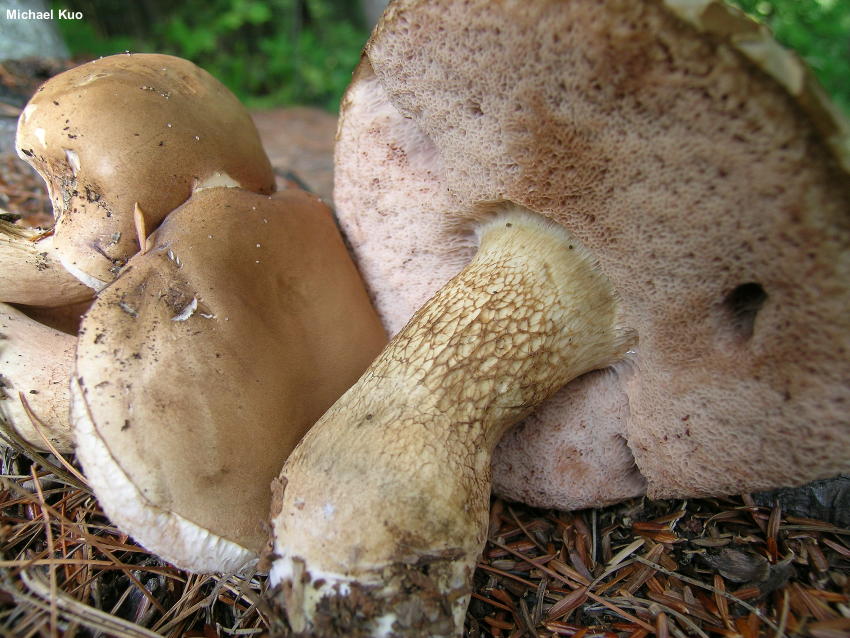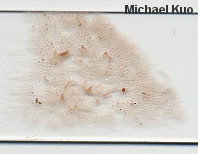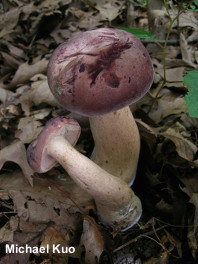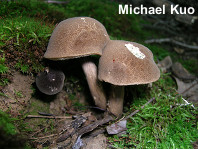Key to 34 Tylopilus and Tylopilus-like Species in North America 
| 2. | Young cap bright orange to orange-red; pore surface bruising brown. | |
| 2. | Young cap not orange; pore surface bruising brown or not. | 3 |
| 3. | Young pore surface brown; stem with Leccinum-like scabers; young cap velvety, purplish brown. | Sutorius eximius |
| 3. | Young pore surface not brown; stem without scabers; young cap velvety or not, variously colored. | 4 |
| 4. | Young stem (ignore the cap) with purple to lilac shades. | 5 |
| 4. | Young stem without purple to lilac shades. | 6 |
| 5. | Spores 7–10 µm long; cap bruising rusty purple to dark purple; stem bruising yellow to yellow-brown, lacking olive discolorations. | Tylopilus violatinctus |
| 5. | Spores 10–13 µm long; cap not bruising; stem sometimes bruising olive to olive brown. | |
| 6. | Young cap white to whitish. | 7 |
| 6. | Young cap more highly colored. | 10 |
| 7. | Stem coarsely and dramatically pocketed-reticulate; found in pine-oak woods from New Jersey to Florida and Texas. | |
| 7. | Stem smooth or, if reticulate, not coarsely so; variously distributed. | 8 |
| 8. | Distribution northeastern and Midwestern, extending into the southern Appalachians; stem bruising and staining brown; cap "skin" thin and papery, often peeling and fragmenting with age. | Tylopilus intermedius |
| 8. | Distribution southeastern, extending into the southern Appalachians; stem not bruising brown; cap skin not as above. | 9 |
| 9. | Usually associated with pines; spores 10–14 µm long. | |
| 9. | Usually associated with hardwoods; spores 7–10 µm long. | Tylopilus peralbidus |
add 1 below
| 10. | Stem not reticulate, or only very finely so at apex. | 12 |
| 11. | Associated with conifers; reticulation coarse; cap 5–13 cm across. | |
| 11. | Associated with oaks (but often in pine-oak forests); reticulation fine; cap 2–6 cm across. | Tylopilus minor |
| 12. | Young cap purple to purple-brown (but older caps may lose all traces of purple). | 13 |
| 13. | Widely distributed east of the Great Plains; stem developing olive to olive brown stains and discolorations; iron salts negative to pinkish on flesh; spores 9–14 µm long. | |
| 13. | Distributed from Florida to Mexico; stem not developing olive stains; iron salts greenish on flesh; spores 7.5–11 µm long. | Tylopilus williamsii |
| 14. | Cap, stem, and pore surface staining brown when bruised; usually found in pine-oak woods; flesh white with distinctive semi-transparent marbling. | Tylopilus rhodoconius |
| 14. | Pore surface staining brown but not the cap, nor the stem; usually found in hardwoods forests; flesh whitish to yellowish, without marbling. | Tylopilus appalachiensis |
| 15. | Found from the Rocky Mountains westward. | 16 |
| 15. | Found east of the Rocky Mountains. | 19 |
| 16. | Young pore surface brown; associated with conifers (Sitka spruce, pines); stem medium to dark brown. | Porphyrellus porphyrosporus |
| 16. | Young pore surface not brown; associated with hardwoods or conifers; stem whitish to tan. | 17 |
| 17. | Associated with pines; mushrooms fairly small (usually under 10 cm), often growing underground and emerging at maturity; stem stout, often not completely central, not reticulate. | Tylopilus humilis |
| 17. | Associated with hardwoods; mushrooms larger and not developing underground; stem not normally stout, usually central, reticulate or not. | 18 |
| 18. | Stem not reticulate; associated with black oak. | Tylopilus ammiratii
in Thiers, 1975 |
| 19. | Pore surface, and often the flesh, bruising or staining blue. | 20 |
| 19. | Blue staining absent. | 21 |
| 20. | Under hardwoods; young pore surface whitish; odor not distinctive; spores 4–6 µm wide. | |
| 20. | Under conifers; young pore surface brown to brownish; odor foul or reminiscent of chlorine (crush the stem base); spores 6–7.5 µm wide. | Porphyrellus porphyrosporus |
| 21. | Stem without scabers. | 23 |
| 22. | Scabers dark; cap purplish brown; young pore surface brown. | Sutorius eximius |
| 22. | Scabers pink to red; cap pink to pinkish tan; young pore surface whitish. | |
| 23. | Stem prominently reticulate over the upper one-third or more. | 24 |
| 23. | Stem not reticulate, or merely finely so at apex. | 26 |
| 24. | Cap and stem dark gray; flesh gray. | Tylopilus griseocarneus |
| 24. | Cap and stem not gray; flesh not gray. | 25 |
| 25. | Associated primarily with southern oaks along the Gulf Coast (but also reported from North Carolina and West Virginia); pore surface whitish becoming brownish to brown, not rapidly bruising; sliced flesh turning purplish. | Tylopilus tabacinus |
| 25. | Associated with oaks throughout the Midwest and eastern North America; pore surface white becoming pinkish brown, bruising brown promptly; sliced flesh turning brownish in places. | |
| 26. | Fresh cap bright orange; distributed south of a line between Boston and Dallas. | |
| 26. | Fresh cap not bright orange; variously distributed. | 27 |
| 27. | Young cap shaggy and scaly, broadly conic, golden to yellow-brown, with tissue hanging from the margin; found under pines in the southeastern United States. | Veloporphyrellus conicus |
| 27. | Cap variously colored but never scaly, shaggy, conic, or with tissue hanging from the margin; variously distributed. | 28 |
| 28. | Sliced flesh eventually turning gray to black, with or without a reddish stage first, over the course of 20 minutes; cap usually very dark (black, dark gray, very dark brown); pore surface bruising black to blackish brown. | 29 |
| 28. | Sliced flesh not turning black to gray after 20 minutes; cap color varying but not usually as above; pore surface, if bruising, bruising pink or pale to medium brown. | 32 |
| 29. | Young pore surface gray, maturing to brown; stem very dark brown; spores 11–20 µm long. | Tylopilus nebulosus |
| 29. | Young pore surface white, maturing to pink or brown; stem black or dark brown; spores under 12 µm long. | 30 |
| 30. | Flesh when sliced staining blackish to black without a red stage; associated with eastern hemlock. | Tylopilus atratus |
| 30. | Flesh staining first red, then black when sliced; associated with oaks. | 31 |
| 31. | Cap black and, when fresh and young, velvety; widely distributed east of the Great Plains. | |
| 31. | Cap brown and bald; known from the Appalachian Mountains. | Tylopilus atronicotianus |
| 32. | Cap, stem, and pore surface bruising strongly brown; stem with a distinctive white apex; flesh when sliced whitish, marbled with colorless areas; known from Florida to Cape Cod. | Tylopilus rhodoconius |
| 32. | Cap and stem not notably bruising; pore surface bruising or not; stem apex white or not; flesh not marbled; variously distributed. | 33 |
| 33. | Associated with eastern hemlock; stem usually proportionally long and slender; spores minutely pitted at maturity. | |
| 33. | Associated with oaks and other hardwoods; stem not normally long and slender; spores not pitted. | 34 |
| 34. | Stem whitish at first, sometimes maturing to brownish but never highly pigmented; spores 10–15 µm long. | |
| 34. | Stem brown to reddish brown or purplish brown, pigmented from the beginning; spores variously sized. | 35 |
| 35. | Young cap brown to reddish brown; young specimens often notably stocky and firm-fleshed; spores 10–14 µm long. | |
| 35. | Young cap maroon; young specimens not usually stocky or firm-fleshed; spores 8–11 µm long. | |
References used for this page can be found in the reference list for boletes.
This site contains no information about the edibility or toxicity of mushrooms.
Cite this page as:
Kuo, M. (2016, September). The genus Tylopilus. Retrieved from the MushroomExpert.Com Web site: http://www.mushroomexpert.com/tylopilus.html
© MushroomExpert.Com
|




